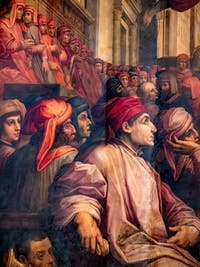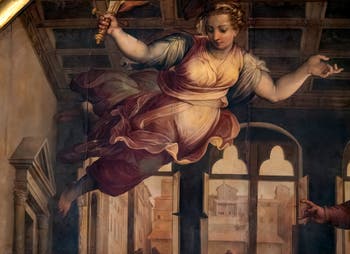Palazzo Vecchio Art Story | Location | Opening Hours Tickets | Authorizations
Art Story Five-Hundred | Tower | Vasari Halls | Dante Mask | Ghirlandaio | Bronzino Sarto Daddi | Salviati | Cortile
Five-Hundred Hall Hall and Ceiling | Ceiling Paintings | Pisa War | Siena War | Sculptures
Ceiling Paintings Cosimo I Medici | Florence History | Wars and Battles | Tuscany
Wars and Battles Paintings of the Ceiling of the Hall of Five Hundred of the Palazzo Vecchio in Florence
Giorgio Vasari and Giovanni Stradano, “Defeat of Radagaise king of the Goths in Fiesole” on the ceiling of the Hall of Five Hundred of Palazzo Vecchio in Florence, Italy
This painting depicts the defeat in 415 of the Goths' King, Radagaise (or Radogast), the successor of Alaric I.He came to Italy with troops in large numbers.
The legend spoke of 400,000 Goths and invaded much of Lombardy and Tuscany.
His last task in Tuscany was to take possession of Florence, whose assault he began on August 406.
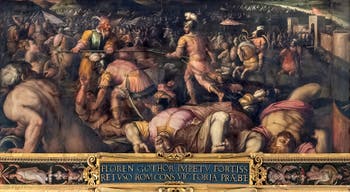
Defeat of Radagaise But the Roman troops, allied with the Visigoths and the Huns, came to the aid of the Florentines and Radagaise had to be entrenched on the heights of Fiesole and in the nearby valleys.
A very unfavourable position for the Goths who found themselves cornered in arid places and deprived of sufficient food to feed their 200,000 soldiers.
The Roman troops commanded by Roman General Flavius Stilicho, father-in-law of Emperor Flavius Honorius, taking advantage of the famine that affected the armies of the Goths, decided to attack them.
Almost half of Radagaise's troops were killed, and the survivors gave up to the Romans.
Radagaise, king of the Goths, was captured and executed.
Under Vasari's painting, we read: “FLOREN [TIA] GOTHOR [UM] IMPETU FORTISS RETUSO ROM. CONS. VICTORIA [M] PRAEBET”.
Giorgio Vasari and Giovanni Stradano, “Deliberation on the War of Pisa and harangue of Antonio Giacomini” Ceiling of the Hall of Five Hundred of Palazzo Vecchio in Florence
In this painting, we can see the Signoria, the council of Florence, in full deliberation to decide whether or not to wage war against Pisa.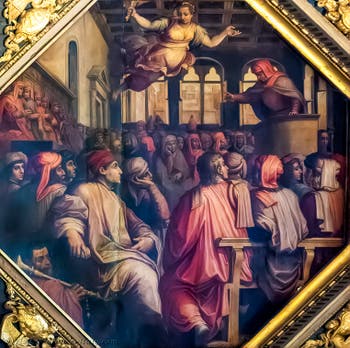
Deliberation on War of Pisa The setting takes place in the Duecento room of Palazzo Vecchio, recognizable by the two-bay windows of the fourteenth century and its coffered ceiling that can be seen in the back.
On the right in the pulpit, we can see Antonio Giacomini haranguing the members of the Signoria.
At the top of the painting, Vasari depicted a Nemesis who holds a sword of fire that demands revenge against the Pisans who had rebelled against Florence.
At this meeting, the Council of Citizens of the Republic of Florence will decide to wage war again against Pisa. On the other hand, there is a doubt about the meaning of this painting.
Indeed, Vasari inscribed on his right the date of 1505 when the deliberation on the Pisa war was 1491.
In 1505, Signoria's deliberation focused on creating a Florentine army consisting of Florentine citizens instead of mercenaries for the continuation of the war against Pisa.
Under the octagonal table is inscribed: “S.P.Q. FLOR [ENTINUS] PISANIS REBELLIB [US] MAGNO ANIMO BELLUM INDICIT”.
Giorgio Vasari and Giovanni Stradano, “Taking of Vicopisano” Ceiling of the Hall of Five Hundred of Palazzo Vecchio in Florence
In the centre of this Vasari battle painting, you can see Swiss soldiers accompanied by the cavalry and other soldiers.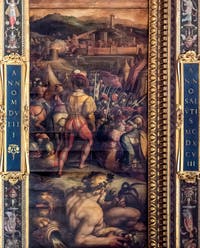
Taking of Vicopisano Vicopisano Castle is represented at the top of the painting.
The Swiss and Florentine troops, during this battle in 1498, were under the command of Paolo Vitelli.
The Florentine general had established his camp at Vico Pisano in the direction of San Giovanni della Vena.
In this way, he cut off the road with any help to the besieged that might have come from Pisa.
Vitelli had also positioned his artillery in such a way as to do maximum damage to the inner walls of the city.
This strategy paid off because the inhabitants saw that they could not be rescued by Pisa gave up to the Florentines.
In the foreground, an old man symbolizes the river Arno accompanied by the lion of Florence.
Under the table is written: “VICUM FLOR [ENTINI] MILITES IRRUMPUNT”.
Giorgio Vasari and Giovanni Stradano, “Defeat of the Venetians in Casentino” Ceiling of the Hall of Five Hundred of Palazzo Vecchio in Florence
In this octagonal painting, Vasari represented the defeat of the Venetian armies by those of Florence in the Casentino region, Vernia and Montalone in winter 1498.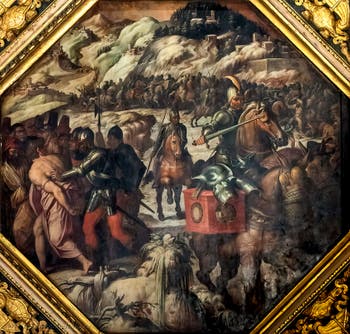
Defeat of Venetians in Casentino The painter clearly showed the harshness of the snowy and icy mountain landscape.
During the winter of 1498, the Venetian troops had been sent as reinforcements to the Pisans.
The Venetians were under the command of Guidubaio Duke of Urbino, Carlo Orsini and Bartolomeo d'Alviano.
They found themselves blocked in the Casentino after the closure of the surrounding passes by Florentine General Paolo Vitelli.
The Florentine troops, assisted by the inhabitants of the valley, then took advantage of their position to launch repeated attacks against the Venetians who went to the Florentines.
Under the painting, we read the following inscription: “VENETI PISARUM DEFENSORES VICTI”.
Giorgio Vasari and Giovanni Stradano, “Taking of Cascina” Ceiling of the Hall of Five Hundred of Palazzo Vecchio in Florence
In this capture of Cascina, the Florentines were commanded by General Paolo Vitelli, who forcibly enter the city with his troops while his artillery fires against the ramparts.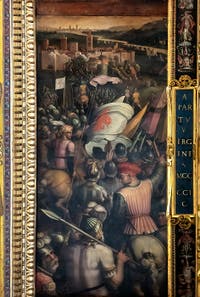
Taking of Cascina Florentine General Paolo Vitelli is represented on horseback in the foreground, recognizable thanks to his command stick that he holds in the air.
The flag of the Florentines shows a red lily on a white background.
The tents around the city symbolize the siege of the city before its final conquest.
A siege that lasted only twenty-six hours before Cascina's surrender, thanks to the firepower of the Florentine cannons.
This event took place on 26 June 1499 during the resumption of hostilities between Florence and Pisa.
Recall that in this war, Pisa was supported by the troops of the king of France while Florence was allied to the Duke of Milan.
Under the table it is read: “CASCINA SOLIDA VI EXPUGNATUR”.
And on the right, the date: “A PARTU VIRGINIS MCCCCCIC”.
Giorgio Vasari and Giovanni Stradano, “Naval Battle between Florentines and Pisans” Ceiling of the Hall of Five Hundred of Palazzo Vecchio in Florence
This naval battle took place in the spring of 1509.Five large galleys and two Florentine armed boats attacked the Pisan ships at the mouth of the Arno.
The Pisan boats were loaded with wheat to help Pisa resist the siege of the Florentines.
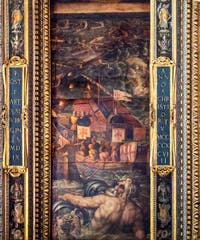
Naval Battle These food aid came from Lucca and Genoa.
To block this attempt to supply Pisa, the Florentines gathered a small fleet and at the same time sent troops to the shores near the places where the Pisan convoy was to pass.
In this way, they forced the Pisan convoy to continue its route to the mouth of the Arno.
Between the mouth of the Arno and Fiumemorto, the Florentines had arranged troops and their artillery along the banks of the river.
Seeing that they could no longer advance without taking significant risks and that they could no longer be able to land their food, the Pisan ships turned back towards the coast of Genoa.
Three of the Pisan brigs loaded with wheat were then sunk by the Florentines.
At the bottom of Vasari's painting, we see Neptune with a Triton who witnesses the victory of the Florentines.
Under the table, Vasari wrote the following words: “COMEATU AND SPE EXCLUDUNTUR”.
Giorgio Vasari and Giovanni Stradano, “The Triumph After the War of Pisa” Ceiling of the Hall of Five Hundred of Palazzo Vecchio in Florence
After the surrender of Pisa after thirteen years of war, this painting by Vasari depicts the triumph of Florentine troops in Florence on June 8, 1509.Vasari chose to represent this triumphant return by equating it to the Roman triumphs.
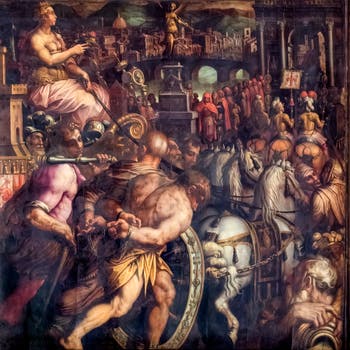
Triumph After the War of Pisa To do this, he incorporated distinctive elements of Ancient Rome into his painting.
The most obvious of them is the chariot pulled by four white horses behind which prisoners walk with their hands tied in the back.
At the top of the tank, Florence is symbolically represented crowned and carrying a bouquet of flowers.
Vasari also painted a triumphal arch to the right of the Carraia Bridge, through which Florentine troops are preparing to enter Florence.
The Arno River is represented under the bridge and allegorically at the bottom and right of the painting, topped by a horn of abundance full of fruits and holding a vase from which the water of the river flows.
The Florentines, lined up on either side of the triumphant procession, welcome the winners.
Under the painting, we can read: “LAETA TANDEM VICTORIA VENIT”.
Giorgio Vasari, “Taking of Monastero” Ceiling of the Hall of the Five Hundred of Palazzo Vecchio in Florence
Giorgio Vasari represented here the great fight between the Florentines and the Sienese in Monastero, a place close to Siena and mainly well defended by forts and walls, as can be seen on the painting.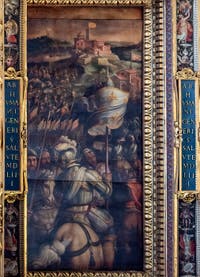
Taking of Monastero The capture of Monastero was made by both infantry and cavalry.
This was one of the first military operations that followed the assault on the fort at the Porte Camollia in Siena.
Like other cities around Siena, such as Villa de Belcaro or Leccetto, Monastero was part of the catch to be ensured by the troops of Florence, led by the Marquis of Marignano to encircle Siena and conquer the city.
Monastero was the most important of the towns close to Siena, hence the importance of its conquest.
Monastero and its forts were then protected by the troops of Cornelio Bentivoglio, which consisted of 800 infantrymen.
It was conquered on 10 April 1554 at dawn, in an assault that, taking advantage of thick fog, used this surprise effect to cut off the possibilities of connections with the city of Maremma.
Under the painting, Vasari wrote: “PRAELIUM ACRE AD MONASTERUM”.
Giorgio Vasari and Giovanni Stradano, “Battle of Marciano in Val di Chiana” on the ceiling of the Hall of Five Hundred of Palazzo Vecchio in Florence, Italy
This painting is different from the large fresco below on the wall of the Hall of Five Cents of Palazzo Vecchio, which dedicates the final victory of the Florentines.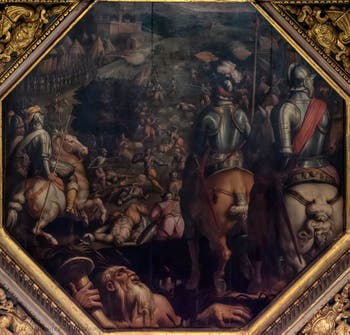
Battle of Marciano The battle here depicted follows the unsuccessful assault of Medici and imperial troops against the fort of Marciano held by the French and Florentine rebels under the orders of Pietro Strozzi.
The battle, led on the Florentine side by the Marquis of Marignano, lasted more than ten hours until sunset with heavy losses for each of the belligerents and without a decisive victory for either side.
This first battle took place on July 29, 1554.
It took three days of terrible fighting between the two enemies before Florence's final victory on 2 August 1554.
At the bottom of the table, Vasari incorporated a river deity to represent the Chiana marsh.
Under the table is written: “GALLI REBELLESQ [EU] PROELIO CEDUNT”.
Giorgio Vasari and Giovanni Stradano, “Defeat of the Turks in Piombino” on the ceiling of the Hall of Five Hundred of Palazzo Vecchio in Florence, Italy
On the night of 12 July 1555, a Turkish fleet, allied with the Florentine rebels and the French commanded by Piero Strozzi, appeared in front of Piombino.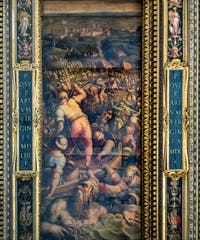
Defeat of the Turks This fleet consisted of 90 galleys and 20 warships.
Duke Cosimo I of Medici's captain, Chiapino Vitelli, led the Florentine troops and their Italian and German allies to face this enemy fleet.
Near the town of Piombino, in Sant'Anastasia, 3,000 Janissaries attempted a landing which was repelled, but with heavy losses for the German troops and the cavalry commanded by Leone da Carpi.
After only two hours of fighting, the Turks were forced to reembark to escape the massacre of their troops.
Vasari's painting shows the rout of the Turks who flee and cling as they can to boats.
Vasari also depicted an old man symbolizing the sea and holding a coral branch in his hand.
Under the table is written: “PUBLICI HOSTES TERRA ARCENTUR”.
Ceiling Paintings Cosimo I Medici | Florence History | Wars and Battles | Tuscany
Five-Hundred Hall Hall and Ceiling | Ceiling Paintings | Pisa War | Siena War | Sculptures
Art Story Five-Hundred | Tower | Vasari Halls | Dante Mask | Ghirlandaio | Bronzino Sarto Daddi | Salviati | Cortile
Palazzo Vecchio Art Story | Location | Opening Hours Tickets | Authorizations
Back to Top of Page


